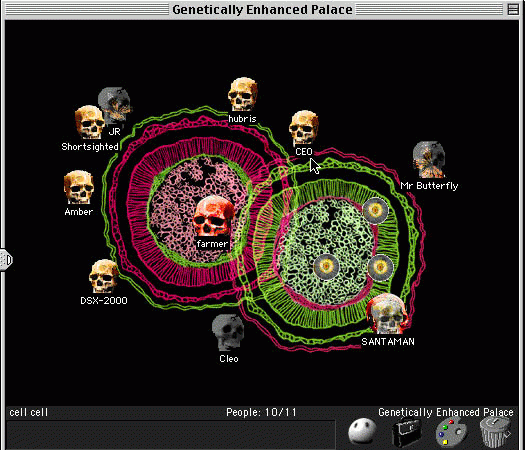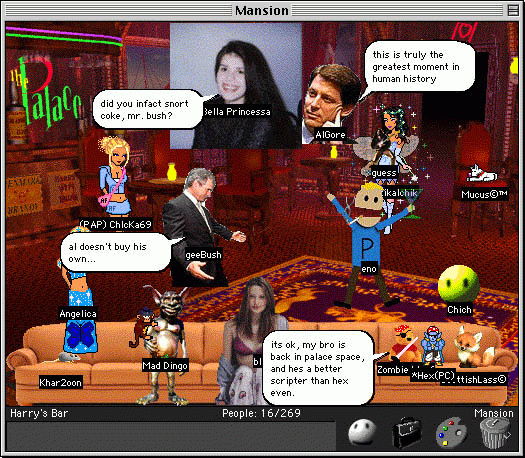Projects / DESKTOP THEATER
DESKTOP THEATER, 1997-2002
Internet Street Theater (1997-2002)
Co-Creator
(w/Lisa Brenneis and Desktop Theater troupe)
›› Director, Producer, Performer, Graphic designer, Programmer ››
ARTIST’S STATEMENT
Created with Lisa Brenneis over 5 years, Desktop Theater was an early experiment in networked performance. Along with the Desktop Theater Troupe, we created more than 40 live and "doubly-live" web-based performances, including "waitingforgodot.com" and the 3 act, 11 person, 4 time zone production "Santaman's Harvest."
DESKTOP THEATER is an ongoing series of live theatrical inventions.
DESKTOP THEATER is made whenever intentional theater-like activity wafts through the layers of unintentional drama and surreal banality encountered in online visual chat rooms.
Street theater for the new Downtown.
In this shared cartoon arena, we are simultaneously static, and in motion; hidden, yet pictured; silent, yet speaking; alone, yet crowded into a small space.
What lures Desktop Theater back to this place again and again?
The opportunity to slip between the cracks of belief and disbelief, to pry ourselves off detachment for this short time before All-Knowingness returns with its constant companion Whatever.
-Adriene Jenik and Lisa Brenneis, DESKTOP THEATER MANIFESTO
The first Desktop Theater production was an adaptation and performance of Samuel Beckett's well-known drama "Waiting for Godot" in an internet chat environment. That early experiment involved a virtuosic triggering of quick key expressions and the cutting and pasting of text from a word processing program in well-paced intervals.
Since then we compressed several other written works, as well as developing original material for a growing international troupe of actors (including Nancy Reilly-McVittie, John Rouse, Elia Arce, Helen Varley Jamieson, and Jack Waters).
Avatar-based improvisations represented the next step in our theatrical inventions. Each of these improvisations was spawned by an initial idea which led to a fast and furious avatar production session, and culminated in an "outing," ending with an analysis of what occurred.
At times we were both "in" on the concept. At other times, one of us instigated a narrative scenario & the other following along. In many instances our presence provoked passionate discussions of online performativity, identity and ethics.
Each of these interventions began with the question, "What would happen if we...?"
Desktop Theater Activities represent alternative models for online play. They are inspired in equal parts by the crude, yet wondrously customizeable Palace software environment, and our lifelong enjoyment of poetry, symbolism, and ritual.
Poetry is at the core of the ActiveVerse experiments. The SPAM poems, performed in the back alleys and hallways of the Genetically Enhanced Palace, are a method of critically and pleasureably recycling digital junkmail.
During 2000-2001, Desktop Theater introduced our practice through workshops into classrooms and community centers throughout Southern California. At Cal State University, San Marcos, UCIrvine, UC San Diego, San Diego High School, and REACH LA, we encouraged young artists and writers to work collaboratively and produce public performances and social interventions.
“In their project Desktop Theater (1997-present), Adriene Jenik and Lisa Brenneis ‘invade’ The Palace chat environment and use their avatars to stage performances, such as an adaption of Samuel Beckett’s Waiting for Godot. The theatrical interventions (in which anyone can take part) become experimental investigations of the construction of online identity where forms of expressions are compressed into two dimensions.
The crude graphics of the environment and the spontaneous and puzzled reactions of people who happen to stumble into the choreographed performance add a humorous aspect to the work, and at the same time reflect on the contextual parameters of performance, be it the role-play of theatre or that of life.”
“The Godot performance was riveting in part because the script was well matched to the mechanical-sounding text-to-speech converter. It did not bring many outside users to interact at length (the play still moved forward without much change induced by the hecklers) and did not keep any evidence of visitors in the space - users could not change or leave things behind in the space except a fleeting comment. The space was flat , not dimensional, so the “theatrical” style performance was more metaphoric than actual: while the space was laid out in perspective, the user’s default avatar never changed size, so spatial cues from the environment were not reflected in the character’s bodies...
Looking closely, the performance’s flat spaces are still navigated by characters. Avatars are positioned over flat bar stools, and characters shy away from one another or chase each other across space. While the performances are confined to a flat, small space, there is a significance to the space that suggests it provides meaning beyond that of the flat graphics and mechanical voices.”
“[Regarding Santaman’s Harvest] ...In the process of striving to maintain a sense of drama, or convey topical content in a normally vacuous virtual space, Jenik’s work develops a keen sense of the social and institutional dynamics which shape those spaces and their avatars.”
“The ‘audience’ has an integral role in Desktop Theatre’s performances. Chat room inhabitants find themselves unwitting participants (if they work out they’re in the middle of the play), and their responses vary from full involvement, ... to leaving.
Cyber theatre requires a new approach to the audience, including an awareness of the greater power they have to influence a performance - and the confidence to play with this rather than attempt to control it.”
“As far as I’ve been able to discover, this “Godot” is also a first of another kind — a maiden effort to bring the structure of drama and the weight of a classic text into the crude, ephemeral environment of online chat. In a post-performance discussion, the performers and their audience came to the same conclusion: The hovering possibility of interference — the ever-present threat of street-theater-style disruption — was precisely what was most compelling about the show.
Now, as any actor will tell you, sharing the stage has its ups and downs. In a situation like “Godot.com,” interruptions tend to steal the show. It’s easier to set rules for sharing the stage on a Web site than in a chat room or a live performance. But at least we know where to start. If we understand interactivity to mean interaction between people — in a world where technology allows more people than ever before to create their own art and share it — then all art gradually becomes interactive, and technology becomes as transparent as the pens and books we take for granted today.”

















